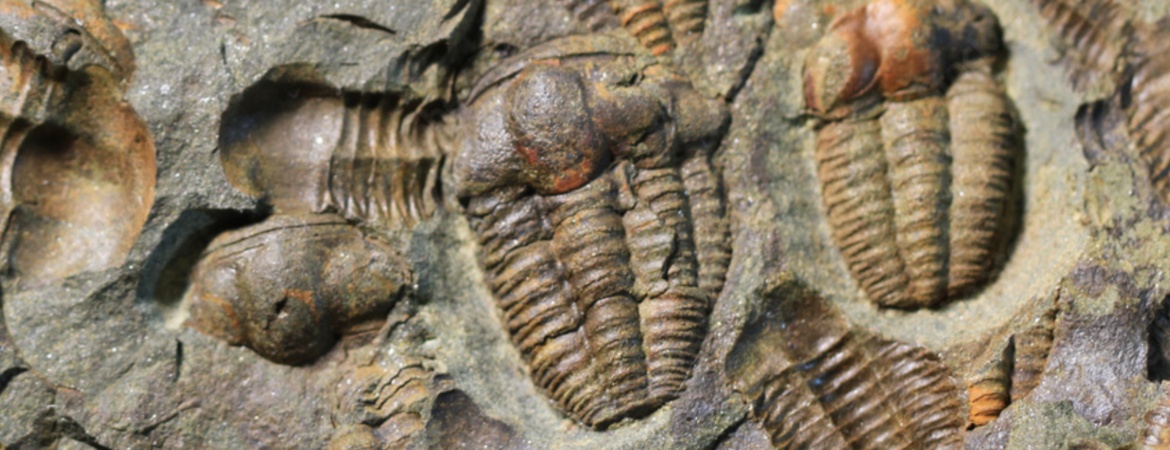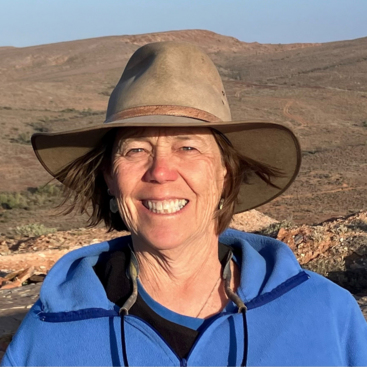
Mary Droser, Distinguished Professor of Geology in the UC Riverside Department of Earth and Planetary Sciences, likes to say that she is the luckiest and most privileged person she knows.
To anyone considering her prodigious list of professional accomplishments, the eponymous head of the Droser Paleoecology Lab on campus certainly seems to have had a long, favored run in the field of paleontology; the crowning achievement being her indispensable participation in the creation of Nilpena Ediacara National Park in South Australia.
Nestled on the western fringes of the Flinders Ranges, Nilpena spans over 60,617 hectares of diverse landscapes, and encompasses the grounds of the former Nilpena Pastoral Station. Australian pastoral ranches – or stations – are typically large land holdings used to raise livestock.
“It’s the most fun and exciting thing that’s happened to me,” Professor Droser says. “That park is based on the work of me and my graduate students over many years. I brought a bunch of people over for the opening, including my husband, who had been there only once for about an hour, my kids, who had always been involved in the research, and many grad students. It was just an extraordinary moment...I would say I’m really lucky.”
On February 5, Professor Droser will kick off the 2025 Science Lecture Series with the talk, "Animals, Sediments, Slime, Muck and Goo: The Record of Earth’s Early Animals and Their Environments with Implications for Discovering Life Elsewhere."
“I’m going to talk about the Ediacara Biota, the oldest record of animals on the planet,” she says. “It’s what my research has been on for decades in Nilpena. We’re looking for life on other planets, but despite all the discoveries of exoplanets, only one planet is known to harbor life, and that’s us. The amazing thing is that we have a phenomenal record of the unfolding of life on Earth.
“I study and will talk about the unfolding of animal life,” she continues, “the dawn of animal life on Earth – long before dinosaurs. This is what we call the Ediacara Biota. It’s a suite of soft-bodied organisms, things like jellyfish and sea anemones...no mineralized skeletons.”
According to Professor Droser, a handful of the Ediacara Biota organisms gave rise to the animal diversity we see today. “That’s what a lot of my last 20 years of research has been about,” she says, work that encompasses the fossils uncovered in Nilpena.
Droser’s interest in paleontology began when she was a small child floating around Shelter Island at the eastern end of Long Island on an inner tube with a snorkel and mask, looking at the bottom of the sea floor.
“That’s kind of what I do today in the Ediacara,” she says. “We have preserved sea floors, but, yeah, that was instrumental in how I got interested in paleontology. When I was five, I wanted to be a marine biologist. When I was 10, I got drawn in by geology...and paleontology is, of course, the combination of those two things.”
Professor Droser counts herself as the rare person that didn’t enter the field through an interest in dinosaurs - she was geology major. “I was incredibly lucky to have had those interests as a kid, she says. "I still go every summer and wander the tidal flats in Shelter Island and look for things.
“I suppose I could have gone into marine biology,” she continues, “but the kinds of things we do on the Ediacara Biota, we are essentially asking the same questions because we are looking at things that are preserved in situ, in the places where they lived. We have all these snapshots of the sea floor. It’s literally equivalent, minus the snorkel and mask. I never really gave it up!”
In 1989, shortly after completing her dissertation on when organisms first started burrowing into the sediment, Professor Droser arrived at UC Riverside. Not too long afterwards, thanks to a colleague who hailed from South Australia, she visited the Flinders Range for the first time, and a whole new world opened up. “It was like Dorothy opening the door to Oz, but Oz in a good way, not scary Oz,” she says. “We knew we had something very special that needed to be preserved.”
Professor Droser says that fossils had been discovered at the station, but had not really been looked at exhaustively. After a talk with the landowners, Ross and Jane Farghar (who Professor Droser considers family), they were given clearance to excavate and turn over whole beds of the fossilized sea floor.
“I had a grant for two years. At the time, my kids were in diapers and came with me,” she says. “They are both now in graduate school. Those two years turned into 25 years. We never really left because once we started doing this, it became this extraordinary record and we’ve been able to excavate now 40 beds and have discovered all sorts of amazing things about the early history of animals on planet Earth. There is no place else like it, and it should be celebrated.”
Over the years, Professor Droser has introduced Nilpena Ediacara National Park to various VIPS, including Kathryn Uhrich, former Dean of CNAS, and Chancellor Kim Wilcox. “This campus, this department, and this college have always allowed me to pursue these interests, and I’ve been incredibly lucky with graduate students and the way they’ve excelled at UCR,” Professor Droser says. “They’ve all gone on to academic jobs...some still work in South Australia, and that speaks to the support of UCR.”
In 2008, Droser discovered the fossil Funisia dorothea on the Flinders Range, and named it after her mother, Dorothy. Funisia was hailed as the first known species to sexually reproduce. “My mom had just retired from a New York City law firm and with my kids still in diapers, she came to Australia every summer and watched over them,” Professor Droser says. “We would go for months with no wi-fi, cell coverage or T.V. in the middle of the Outback. So she certainly deserved at least a fossil named after her...that was an easy one!”
Eight years later Professor Droser named a 550-million-year-old fossil Obamus, after President Barack Obama. The fossil has been reconstructed in 3D and 2D paper drawings, and is part of the Obama Presidential Library. “I heard from the Obama Foundation that they wanted to include it,” she says. "That’s a long process, actually...we wanted to acknowledge Obama’s contributions to science and his enthusiasm for science. It was the right thing for us to do.”
Professor Droser is currently part of team acting on behalf of the Government of South Australia and the traditional owners of the Flinders Rangers, the Adnyamathanha people, to nominate the Ranges as a World Heritage Site. She says that the nomination will be submitted to UNESCO in September of this year for a vote in 2026.
“We’re in good shape, but working very hard,” Prof. Droser says. “We’ve expanded the bid to not just include Nilpena, because there are some other really amazing places in the area that can be helpful in telling the story of the dawn of animal life. I’m in the right place at the right time with a government that gets it, and I'm happy to lean in and help people understand that there is no place like this anywhere in the world, and it should be celebrated.”
Professor Droser teaches a course at UC Riverside called “Headlines in the History of Life” (GEO 003). “We have all this science fiction about monsters, and all you have to do is look at the fossil record, and there are so many dinosaurs...monsters that were real!" she says. "You always get those couple of kids that are just captivated.
“The Earth has a phenomenal history of fits and starts and weirdness,” she continues. “The distribution of life today is such an artifact of the last billion years of evolution. I would say to my students who work on the Ediacara Biota, you have to have an imagination and think outside the box...imagine how these things lived. It’s like figuring out a mystery...you’re being a detective, and that’s fun! You pursue roots and lines of inquiry. We arrive piecemeal with facts and then put the puzzle together. Sometimes it comes slowly and other times you have ‘Eureka!’ moments. They are few and far between, but when they happen, they’re magical moments.”
Professor Droser says good fortune has imbued her life dating all the way back to the idyllic summers she spent floating around the tidal basins of Shelter Island and then coming to UC Riverside as a “green kid” almost 40 years ago and finding a nurturing home. We’d go a bit further and say academic rigor, deep curiosity and hard work have made Professor Droser’s luck...well, a sure thing!
Register for the 2025 Science Lecture Series
